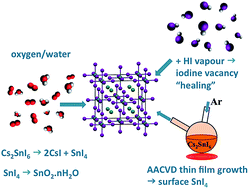Ambient-air-stable inorganic Cs2SnI6 double perovskite thin films via aerosol-assisted chemical vapour deposition†
Abstract
Air-stable caesium tin iodide double perovskite (Cs2SnI6) thin films have been fabricated via aerosol-assisted chemical vapour deposition (AACVD). We compare the properties of the double perovskite films made using AACVD with those made by the widely used spin-coating method. Films with purer crystalline phase (less CsI impurity) and far better stability in ambient air can be obtained by AACVD compared with spin coating. The AACVD-grown Cs2SnI6 films retain high phase purity for at least ∼100 days aging in air with negligible CsI impurities detected over this time, as determined by X-ray diffraction. The films exhibit an optical band gap energy (Eg) of ca. 1.3 eV and a homogeneous morphology with the expected nominal stoichiometry within error, as probed by energy-dispersive X-ray spectroscopy. Overall, the characteristics of the Cs2SnI6 films are highly process-dependent, e.g. they are influenced by the presence of hydroiodic acid (HI) in the precursor solution. Without HI addition, an iodine-deficient film with more CsI is produced, which also exhibits a larger Eg of ca. 1.6 eV. In addition to bulk properties, we utilise X-ray photoelectron spectroscopy (XPS) to scrutinise the surface characteristics in detail. We find excess Sn and I located at the surfaces. This can be attributed to the presence of SnI4 from the deposition precursor vapour. Furthermore, following aging in air, an increase in CsI impurity for the AACVD (+HI)-grown film is observed, along with a reduction in SnI4 at the surfaces. Near-ambient pressure XPS (NAP-XPS) is used to examine the surface stability of AACVD (+HI)-grown films on exposure to O2 and H2O. No enhancement in the amount of CsI impurity is observed after both H2O vapour (9 mbar) and O2 (5 mbar) exposure. Nevertheless, the concentrations of tin and iodine change after exposure, suggesting that SnI4 protects Cs2SnI6 from degradation. This passivation effect of SnI4 on Cs2SnI6 surfaces is proposed to explain the additional stability of Cs2SnI6 fabricated via AACVD.



 Please wait while we load your content...
Please wait while we load your content...